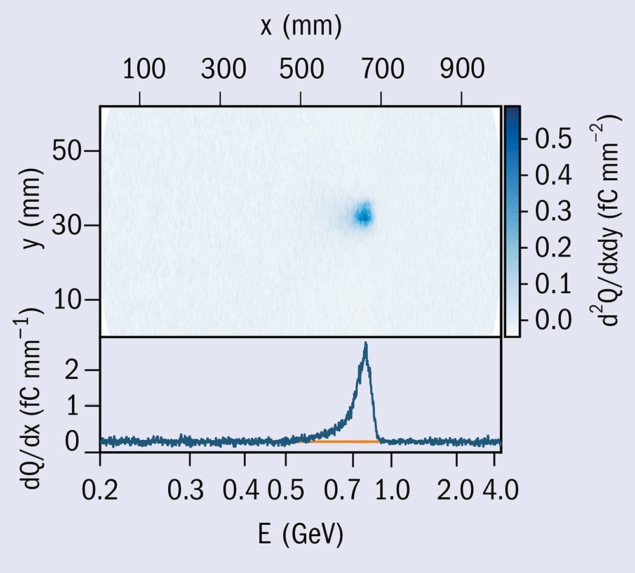
The AWAKE experiment at CERN has passed an important milestone towards compact, high-energy accelerators for applications in future high-energy physics experiments. Reporting in Nature on 29 August, the 18 institute-strong international collaboration has for the first time demonstrated the acceleration of electrons in a plasma wakefield generated by a proton beam. The AWAKE team injected electrons into plasma at an energy of around 19 MeV and, after travelling a distance of 10 m, the electrons emerged with an energy of about 2 GeV – representing an average acceleration gradient of around 200 MV/m. For comparison, radio-frequency (RF) cavities in high-energy linear accelerators used for X-ray free-electron lasers achieve typical gradients of a few tens of MV/m.
Plasma-wakefield acceleration still has far to go before it can rival the performance of conventional RF technology, however. First proposed in the late 1970s, the technique accelerates charged particles by forcing them to “surf” atop a longitudinal plasma wave that contains regions of positive and negative charges. Two beams are required: a “witness” beam, which is to be accelerated, and a “drive” beam that generates the wakefield. Initial experiments took place with laser and electron drive beams at SLAC and elsewhere in the 1990s, and the advent of high-power lasers as wakefield drivers led to increased activity. Such techniques are now capable of bringing electrons to energies of a few GeV over a distance of a few centimetres.
AWAKE (the Advanced Wakefield Experiment) is a proof-of-principle R&D project that is the first to use protons for the drive beam. Since protons penetrate deeper into the plasma than electrons and lasers, thereby accelerating witness beams for a greater distance, they potentially can accelerate electrons to much higher energies in a single plasma stage. The experiment is driven by a bunch of 400 GeV protons from the Super Proton Synchrotron, which is injected into a plasma cell containing rubidium gas at a temperature of around 200ºC. An accompanying laser pulse is used to ionise the rubidium gas and transform it into a plasma. As the proton bunch travels through the plasma, it splits into a series of smaller bunches via a process called self-modulation, generating a strong wakefield as they move. A bunch of witness electrons is then injected at an angle into this oscillating plasma at relatively low energies and rides the plasma wave to get accelerated. At the other end of the plasma, a dipole magnet bends the incoming electrons onto a scintillator to allow the energy of the outgoing particles to be measured (see figure).
AWAKE has made rapid progress since its inception in 2013. Following the installation of the plasma cell in early 2016, in the tunnel formerly used by part of the CNGS facility at CERN, a proton-driven wakefield in a plasma was observed for the first time by the end of the year (CERN Courier January/February 2017 p8). The electron source, electron beam line and electron spectrometer were installed during 2017, completing the preparatory phase beginning in 2018, and the first electron acceleration was recorded early in the morning of 26 May.
So far, the AWAKE demonstration involves low-intensity electron bunches; the next steps include plans to create an electron beam at high energy with sufficient quality to be useful for applications, although tests will pause at the end of the year when the CERN accelerator complex shuts down for two years for upgrades and maintenance. A first application of AWAKE is to deliver accelerated electrons to an experiment and extending the project with a fully-fledged physics programme of its own. For eventual collider experiments, another hurdle is to be able to accelerate positrons. In the longer term, a global effort is under way to develop wakefield-acceleration techniques for a multi-TeV linear collider (CERN Courier December 2017 p31).
Although still at an early stage of development, the use of plasma wakefields could drastically reduce the size and therefore cost of accelerators. Edda Gschwendtner, technical coordinator and CERN project leader for AWAKE, says that the ultimate aim is to attain an average acceleration gradient of around 1 GV/m so that electrons can be accelerated to the TeV scale in a single stage. “We are looking forward to obtaining more results from our experiment to demonstrate the scope of plasma wakefields as the basis for future particle accelerators.”
Further reading
AWAKE Collaboration 2018 Nature 561 363.







